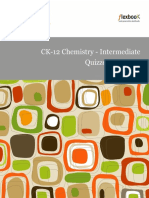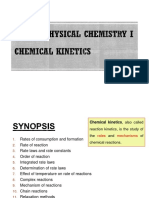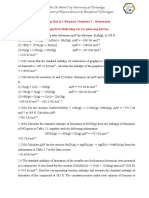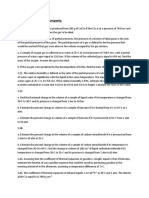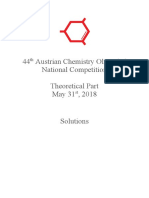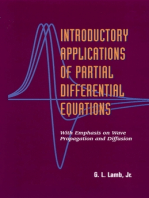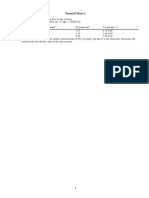Problem Set No. 3
Uploaded by
CJ GoradaProblem Set No. 3
Uploaded by
CJ Gorada1. If the reaction N2 + 3H2 → 2NH3 has d[H2]/dt = -0.
006 mol/L-s at a certain instant, what is d[N2]/dt at that
instant?
2. The first-order reaction 2A →2B + C is 35% complete after 325 s. (a) Find k and kA, where kA is defined in (16.11).
(b) How long will it take for the reaction to be 70% complete? 90% complete?
3. For the gas-phase reaction 2NO2 + F2 →2NO2F, the rate constant k is 38 dm3 mol-1 s-1 at 27°C. The reaction is
firstorder in NO2 and first-order in F2. (a) Calculate the number of moles of NO2, F2, and NO2F present after 10.0 s if
2.00 mol of NO2 is mixed with 3.00 mol of F2 in a 400-dm3 vessel at 27°C. (b) For the system of (a), calculate the
initial reaction rate and the rate after 10.0 s.
4. The reaction n-C3H7Br + S2O3-2 → C3H7S2O3- + Br- in aqueous solution is first order in C3H7Br and first-order in
S2O32- At 37.5°C, the following data were obtained (where c°is 1 mol/dm3 and 1 ks = 103 s):
103[S2O3 2_]/c° 96.6 90.4 86.3 76.6 66.8
t/ks 0 1.110 2.010 5.052 11.232
The initial C3H7Br concentration was 39.5 mmol/dm3. Find the rate constant using a graphical method.
5. For the reaction A + B →C + D, a run with [A]0 =400 mmol dm_3 and [B]0 = 0.400 mmol dm_3 gave the following
data (where c° = 1 mol/dm3):
t/s 0 120 240 360 α
104[C]/c° 0 2.00 3.00 3.50 4.00
and a run with [A]0 = 0.400 mmol dm and [B]0 = 1000mmol dm_3 gave
_3
10_3t/s 0 69 208 485 α
104[C]/c° 0 2.00 3.00 3.50 4.00
Find the rate law and the rate constant. The numbers have been chosen to make determination of the orders simple.
6. The gas-phase reaction 2NO2 + F2 →2NO2F has r = k[NO2][F2]. Devise a mechanism consistent with this rate law.
7. For the gas-phase reaction 2HI → H2 + I2, values of k are 1.2 x 10_3 and 3.0 x 10-5 dm3 mol-1 s-1 at 700 and 629 K,
respectively. Estimate Ea and A.
8. (a) Find the activation energy of a reaction whose rate constant is multiplied by 6.50 when T is increased from 300.0 K
to 310.0 K. (b) For a reaction with Ea=19 kJ/mol (4.5 kcal/mol), by what factor is k multiplied when T increases from
300.0 K to310.0 K?
9. A second-order reaction of the type A + B P was carried out in a solution that was initially 0.050 mol dm-3 in A
and 0.080 mol dm-3 in B. After 1.0 h the concentration of A had fallen to 0.020 mol dm-3. (a) Calculate the rate
constant. (b) What is the half-life of the reactants?
10. For a reversible first order reaction
kf
A B
kb
kf = 10-2 s-1 and Kc = 4. If the initial concentration of B is zero. What concentration of A is
needed to yield 1.0 M of B in 30 minutes?
238
11. The first three steps in the decay of U are
238 234
U 234Th 234Pa U
If we start with pure 238U , what fraction will be 234Th after 1 year?
238
t½ of U = 4.5 x 109 y , 234Th = 24.1 d
You might also like
- CK-12 Chemistry Intermediate Quizzes & Tests (With Answers) PDF50% (8)CK-12 Chemistry Intermediate Quizzes & Tests (With Answers) PDF408 pages
- CHE3044F: Reactor Design 1: TUTORIAL 7, 2012: April 29, 2013No ratings yetCHE3044F: Reactor Design 1: TUTORIAL 7, 2012: April 29, 20132 pages
- Suggested Solutions For Chapter 38: Purpose of The ProblemNo ratings yetSuggested Solutions For Chapter 38: Purpose of The Problem14 pages
- KFT 233 Chemical Kinetics - Student PDFNo ratings yetKFT 233 Chemical Kinetics - Student PDF99 pages
- Basic Principles and Calculations in Chemical Engineering: Solutions Manual To AccompanyNo ratings yetBasic Principles and Calculations in Chemical Engineering: Solutions Manual To Accompany244 pages
- Bài tập Hoá lý 1 (Physical Chemistry 1 - Homework)No ratings yetBài tập Hoá lý 1 (Physical Chemistry 1 - Homework)13 pages
- Bài tập Hoá lý 2 (Physical Chemistry 2 - Homework)No ratings yetBài tập Hoá lý 2 (Physical Chemistry 2 - Homework)10 pages
- 1 N Sodium Hydroxide and 300 MG of Hydroxynaphthol Blue, and Continue The Titration To A BlueNo ratings yet1 N Sodium Hydroxide and 300 MG of Hydroxynaphthol Blue, and Continue The Titration To A Blue3 pages
- Ceramic Materials I: Asst - Prof. Dr. Ayşe KALEMTAŞNo ratings yetCeramic Materials I: Asst - Prof. Dr. Ayşe KALEMTAŞ27 pages
- eBook Quá Trình Và Thiết Bị Công Nghệ Hóa Học Và Thực Phẩm - Bảng Tra Cứu Quá Trình Cơ Học Truyền Nhiệt - Truyền Khối (ĐH Bách Khoa TP.hcm) - 971308No ratings yeteBook Quá Trình Và Thiết Bị Công Nghệ Hóa Học Và Thực Phẩm - Bảng Tra Cứu Quá Trình Cơ Học Truyền Nhiệt - Truyền Khối (ĐH Bách Khoa TP.hcm) - 97130870 pages
- CHFEN 3553 Chemical Reaction Engineering: April 28, 2003 1:00 PM - 3:00 PM Answer All QuestionsNo ratings yetCHFEN 3553 Chemical Reaction Engineering: April 28, 2003 1:00 PM - 3:00 PM Answer All Questions4 pages
- Kiểm tra lý thuyết thí nghiệm hóa lý CH3007 1No ratings yetKiểm tra lý thuyết thí nghiệm hóa lý CH3007 18 pages
- Lab - Activity No. 6 - Rimbao, Alona Jane V.No ratings yetLab - Activity No. 6 - Rimbao, Alona Jane V.5 pages
- Dtu, Department of Energy Engineering H in (KJ/KG) - V in (M 3/Kg) - P in (Kpa) M.J. Skovrup & H.J.H Knudsen. 16-08-16 Ref:R.C.Downing. Ashrae Transactions 1974. Paper No. 2313No ratings yetDtu, Department of Energy Engineering H in (KJ/KG) - V in (M 3/Kg) - P in (Kpa) M.J. Skovrup & H.J.H Knudsen. 16-08-16 Ref:R.C.Downing. Ashrae Transactions 1974. Paper No. 23131 page
- Kinetics of The Partial Oxidation of MethanolNo ratings yetKinetics of The Partial Oxidation of Methanol16 pages
- 2018 National Competition Tasks Theoretical SolutionsNo ratings yet2018 National Competition Tasks Theoretical Solutions24 pages
- 2.1 Exercise 2 - Bond Dissocation EnthalpiesNo ratings yet2.1 Exercise 2 - Bond Dissocation Enthalpies2 pages
- CHM 211 Photochemical RXN 2021 2022 SessionNo ratings yetCHM 211 Photochemical RXN 2021 2022 Session21 pages
- A General Review of Thermodynamic Concepts: KMU220 Chemical Engineering Thermodynamics I100% (1)A General Review of Thermodynamic Concepts: KMU220 Chemical Engineering Thermodynamics I24 pages
- Sách Tối Ưu Hóa Các Quá Trình Công Nghệ Hóa HọcNo ratings yetSách Tối Ưu Hóa Các Quá Trình Công Nghệ Hóa Học178 pages
- Bài tập Hoá lý 2 (Physical Chemistry 2 - Homework)No ratings yetBài tập Hoá lý 2 (Physical Chemistry 2 - Homework)10 pages
- General Chemistry Laboratory Report: Experiment 2 PH and BuffersNo ratings yetGeneral Chemistry Laboratory Report: Experiment 2 PH and Buffers11 pages
- Introductory Applications of Partial Differential Equations: With Emphasis on Wave Propagation and DiffusionFrom EverandIntroductory Applications of Partial Differential Equations: With Emphasis on Wave Propagation and DiffusionNo ratings yet
- QUIZ 1 CHE185-1 57/60: Greenhouse Effect Human ActivityNo ratings yetQUIZ 1 CHE185-1 57/60: Greenhouse Effect Human Activity8 pages
- Chapter 3. Volumetric Properties of Pure Fluids100% (1)Chapter 3. Volumetric Properties of Pure Fluids70 pages
- Problem Set 1.2 Mechanism Nonelementary ReactionNo ratings yetProblem Set 1.2 Mechanism Nonelementary Reaction1 page
- Questions and Problems:: Node Equations N 1No ratings yetQuestions and Problems:: Node Equations N 15 pages
- Questions and Problems:: Node Equations N 1No ratings yetQuestions and Problems:: Node Equations N 15 pages
- 3 Protein Estimation by Folin-Lowry's MethodNo ratings yet3 Protein Estimation by Folin-Lowry's Method2 pages
- Engineering Chemistry - Que Bank - 2024 Pattern..No ratings yetEngineering Chemistry - Que Bank - 2024 Pattern..4 pages
- EcoPoly Data Sheet Template EcoSmooth PDFNo ratings yetEcoPoly Data Sheet Template EcoSmooth PDF1 page
- Sviluppo Del Nuovo Caltronic 28072011 enNo ratings yetSviluppo Del Nuovo Caltronic 28072011 en6 pages
- CFD Analysis of Non-Symmetrical Intake Manifold For Formula SAE CarNo ratings yetCFD Analysis of Non-Symmetrical Intake Manifold For Formula SAE Car11 pages
